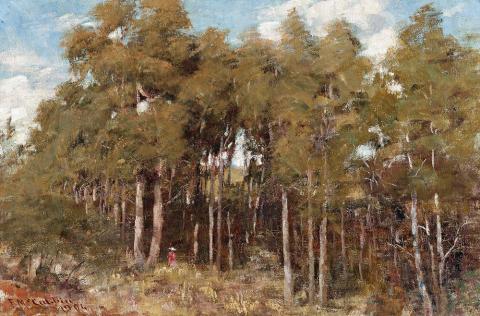A MOUNTAIN CLEARING, MACEDON, 1904
FREDERICK McCUBBIN
oil on canvas on board
29.5 x 45.0 cm
signed and dated lower left: F McCUBBIN / 1904
Andrew Ivanyi Gallery, Melbourne
Private collection, Adelaide, acquired from the above in 1979
Deutscher and Hackett, Melbourne, 24 April 2013, lot 40
Roger Langsworth, Sydney
Possibly Mr Fred McCubbin's Exhibition of Australian Paintings, Athenaeum Upper Hall, Melbourne, 22 April 1904, cat. 20 (as ‘A Mountain Clearing, Macedon')
Paintings of a single figure, often a young woman, in a bush setting appealed greatly to the early Australian Impressionists. Several, such as Frederick McCubbin’s Lost, 1886 (National Gallery of Victoria, Melbourne) and Tom Roberts’ A Summer Morning Tiff, 1886 (Art Gallery of Ballarat, Victoria) have become icons of Australian art. Not only did the motif produce good art, but it was also a very practical one for the artists. The models were often members of the artist’s family or friends, particularly for McCubbin. The figure also had a distinct compositional and aesthetic role to play. It gave scale, and the touch of red, as in our painting, a focal point, offsetting the surrounds of blue-green foliage. McCubbin and Roberts’ nineteenth century paintings were rich in narrative, full of tales of children lost in the bush, hardships of the pioneers and the like. Occasionally, they were elevated to a higher level by association with traditions in Christian art, as in McCubbin’s use of the triptych for The Pioneer, 1904 (National Gallery of Victoria). A comparison of A Mountain Clearing, Macedon, 1904 and The Pioneer, however, shows how far McCubbin’s art had developed in the replacement of literary interests with aesthetic. The single figure in an enveloping bush setting may hint at colonial melancholy, but its chief interests are now the sparkling light and enveloping atmosphere, of delight in the spectacle of nature and her many inviting moods.
Following the McCubbin’s move to their bush home of Fontainebleau on Mount Macedon, landscape played a more dominant role in his art, with the McCubbin children featuring in many an attractive painting. In Childhood Fancies, 1905 (private collection) the models are Sydney and Sheila, Sydney for Lost, 1907 (National Gallery of Victoria), and Kathleen, the youngest of the McCubbin family posed for both the girl and the boy in The Rabbit Burrow, 1910 (private collection). In our painting the figure is so small as to avoid identification, but probably Sheila. The spontaneity with which the scene is painted expresses McCubbin’s delight in the bush, the interplay between sunlight and shade handled with all the verve of Impressionism. Almost certainly included in McCubbin’s solo exhibition of April 1904, the critic for The Age described it as ‘undoubtedly one of the most notable of the “one man shows” that have been held in Melbourne’.1 The Argus called McCubbin ‘a poet in colours’.2 Of The Pioneer, the major work in the exhibition, he described as, ‘… steeped in atmosphere, and the landscape is treated with that sympathy with nature which distinguishes this artist’s work’. 3 The same is true of A Mountain Clearing, Macedon.
1. ‘Art Notes. Mr. M’Cubbin’s Exhibition of Paintings’, Age, Melbourne, 22 April 1904, p. 8
2. ‘Exhibition of Australian Art’, Argus, Melbourne, 22 April 1904, p. 7
3. Ibid
DAVID THOMAS
